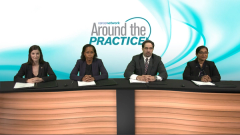
Patient Profile 3: A 73-Year-Old with MM Treated with CAR T and Teclistamab
Al-Ola Abdallah, MD, presents the case of a patient with multiple myeloma treated with CAR T-cell therapy and teclistamab.
Episodes in this series

Transcript:
Al-Ola Abdallah, MD: Moving forward, we’ll talk about case 3. I think this case is more [interesting] because we’re going to have to discuss further about many new treatments. This is a 73-year-old female patient diagnosed with myeloma in 2019. [She was] complaining of back pain. The imaging study initially showed a T7 fracture. This patient got induction therapy already. She was eligible for transplant, but she opted not to do transplant. This is something I think we see in some patients. Her primary oncologist switched her to Cytoxan [cyclophosphamide]-Velcade [bortezomib]-dexamethasone. She did not quite respond. She responded to the Revlimid [lenalidamide]-Velcade-dexamethasone. But because of some ration concerns of intolerance was switched to Cytoxan-Velcade-dexamethasone. Unfortunately, the patient progressed, was switched to daratumumab-Velcade-dexamethasone, and progressed. [She was] switched to pomalidomide-dexamethasone, and progressed on that, and switched to carfilzomib-Cytoxan.
So, we have multiple relapses, and we’re commonly seeing that for patients. We call this patient a triple-class refractory myeloma. So, to identify that for our audience, you have to be refractory to or relapsing on 1 of the 2 proteasome inhibitors, Velcade or carfilzomib, one of the immune modulator drugs, Revlimid or pomalidomide, and one of the CD38 monoclonal antibodies, daratumumab or isatuximab. And this patient met the criteria.
CAR [chimeric antigen receptor] T-cell therapy was offered to this patient. She received it in July 2021, and achieved a complete remission. I think that was the first time she got to complete remission. She responded to other treatment, but unfortunately, she progressed in July 2022. Protein was elevated up to 1.15 gm/dc. [There was a] PET-CT scan. The bone marrow biopsy showed 95% monoclonal plasma cells, TP53 mutations with plus 1q high risk. The PET-CT scan [showed] a lot of scattered soft tissue nodules and masses, with several scattered nodular hypermetabolism throughout the liver and widespread lytic osseous lesions. Now that’s a challenging case.
Now, CAR T, although was not the standard care, we have a phase 2 study we were excited about in triple-refractory myeloma. So, we made the right decision. We decided to go with something new, which is teclistamab. The same target as the BCMA CAR T-cell therapy. And here’s the results. We’re surprised. You can see in our results, this patient actually achieved a stringent complete remission with teclistamab. The M protein dropped to zero, and the bone marrow biopsy from 95% to 0%. The PET-CT scan showed complete remission in even extramedullary disease. So, we have a response here.
I think this is actually a decision that we always have to make, is to talk about, first of all, the relapsed myeloma. And defining relapsed myeloma is one important thing. First of all, this patient has progressed on multiple lines, and I always try to be careful when I move from one line to another line. I don’t want to exhaust all these lines of therapy, especially if the patient was doing fine. One of the things I try to do is evaluate how significant is that elevation of the free markers. I follow these patients, especially in the maintenance therapy, and if I see it’s really significant, [goes] up, I try to change the treatment as soon as possible. I think that’s one of the major things I do.
One of the other things I try to do is, that if I see there’s a small trend up, before I make a decision, I might restage the patient with a PET scan, bone marrow biopsy, or any imaging studies. And the reason for that is just based on the fact that I don’t want to change the treatment faster, especially if there’s a mild revision of the free light chain. So, if the patient already has end organ damage or extramedullary disease, or plasmacytoma, its obvious there’s no way you were going to wait for any significant change of myeloma markers. So that’s where I like to talk about it.
Now, this patient really did really good on the teclistamab, and she actually responded well to it. But unfortunately, she got admitted to the hospital and was diagnosed with pneumonia, required BiPAP [bilevel positive airway pressure], and had 2 viral infections, RSV [respiratory syncytial virus] and parainfluenza. Now she’s doing better after we treated her. I think we need to talk a little bit about that treatment for it.
But before we talk about this case, one of the things we want to talk about is the first relapse. I don’t know if anybody will agree or disagree, especially with the quadruple therapy, daratumumab-based therapy is still a standard in early relapse. Any disagreement in that regard? Because daratumumab or isatuximab have been proven as a combination therapy that they can actually work all together with other agents [such as] Velcade and carfilzomib. [They can] also work with Revlimid and pomalidomide. I think one of the things here is that we can utilize that, there’s now results of not only PFS and overall survival, but it’s showing exactly more significant results, making the daratumumab as effective.
Transcript edited for clarity.
Newsletter
Stay up to date on recent advances in the multidisciplinary approach to cancer.


















































































